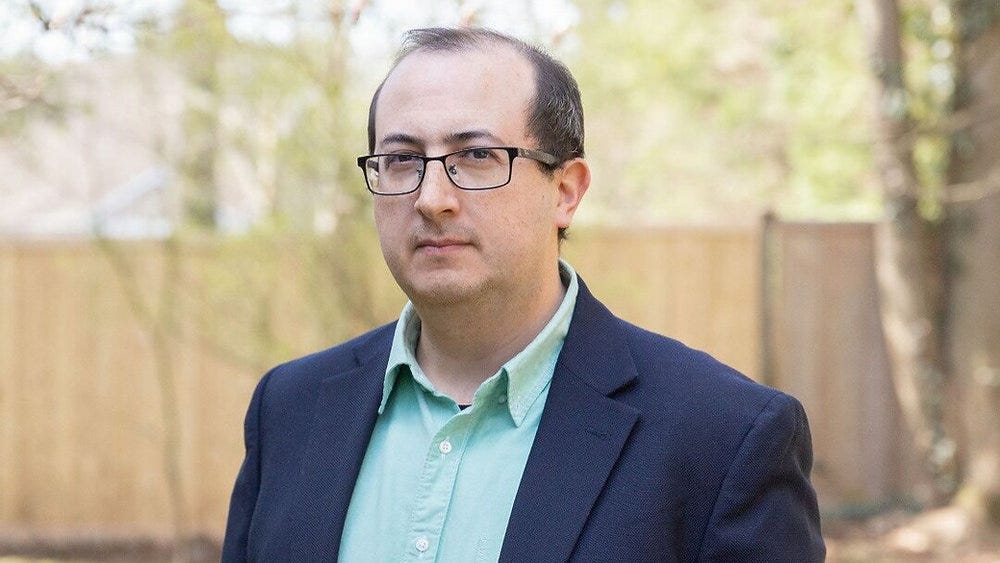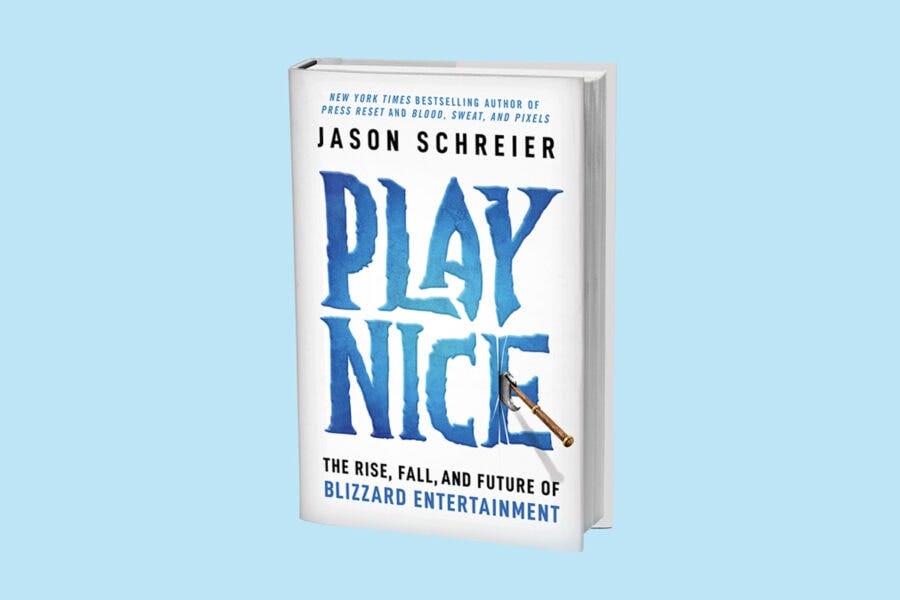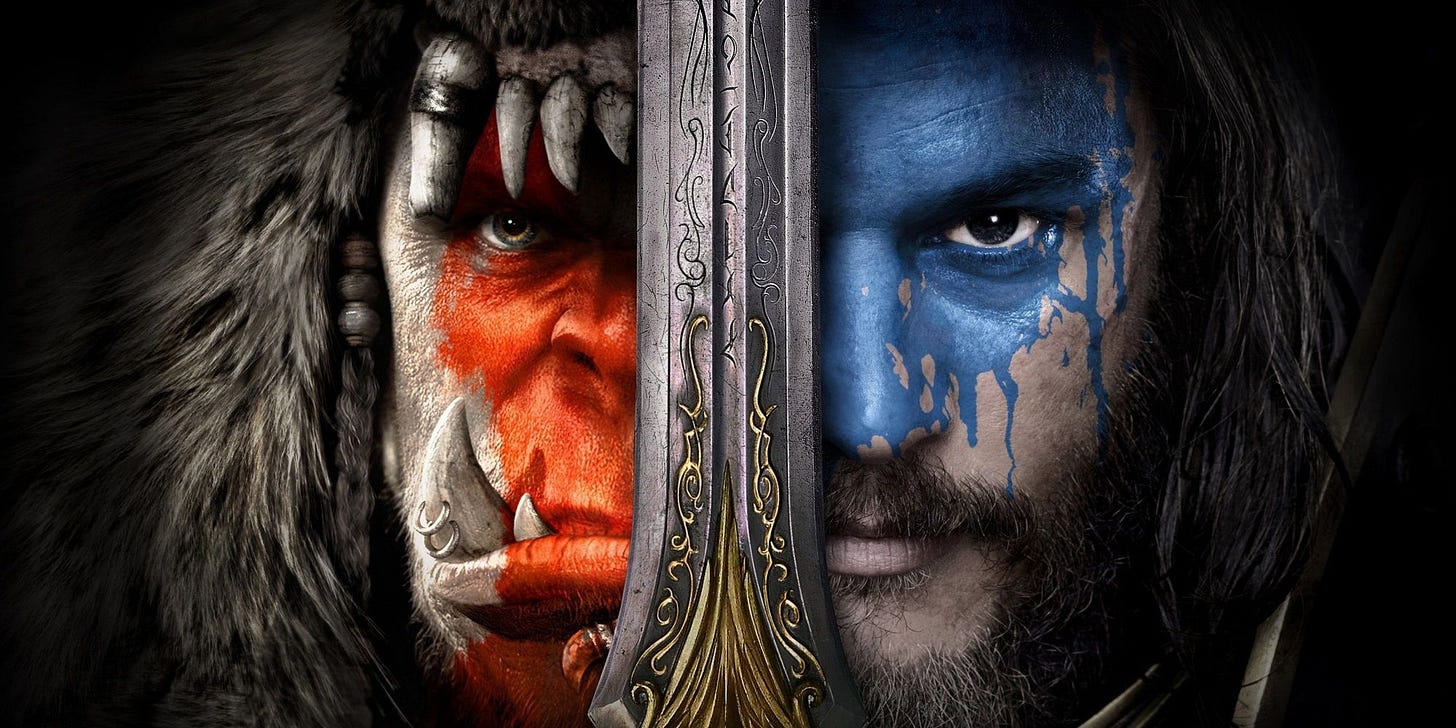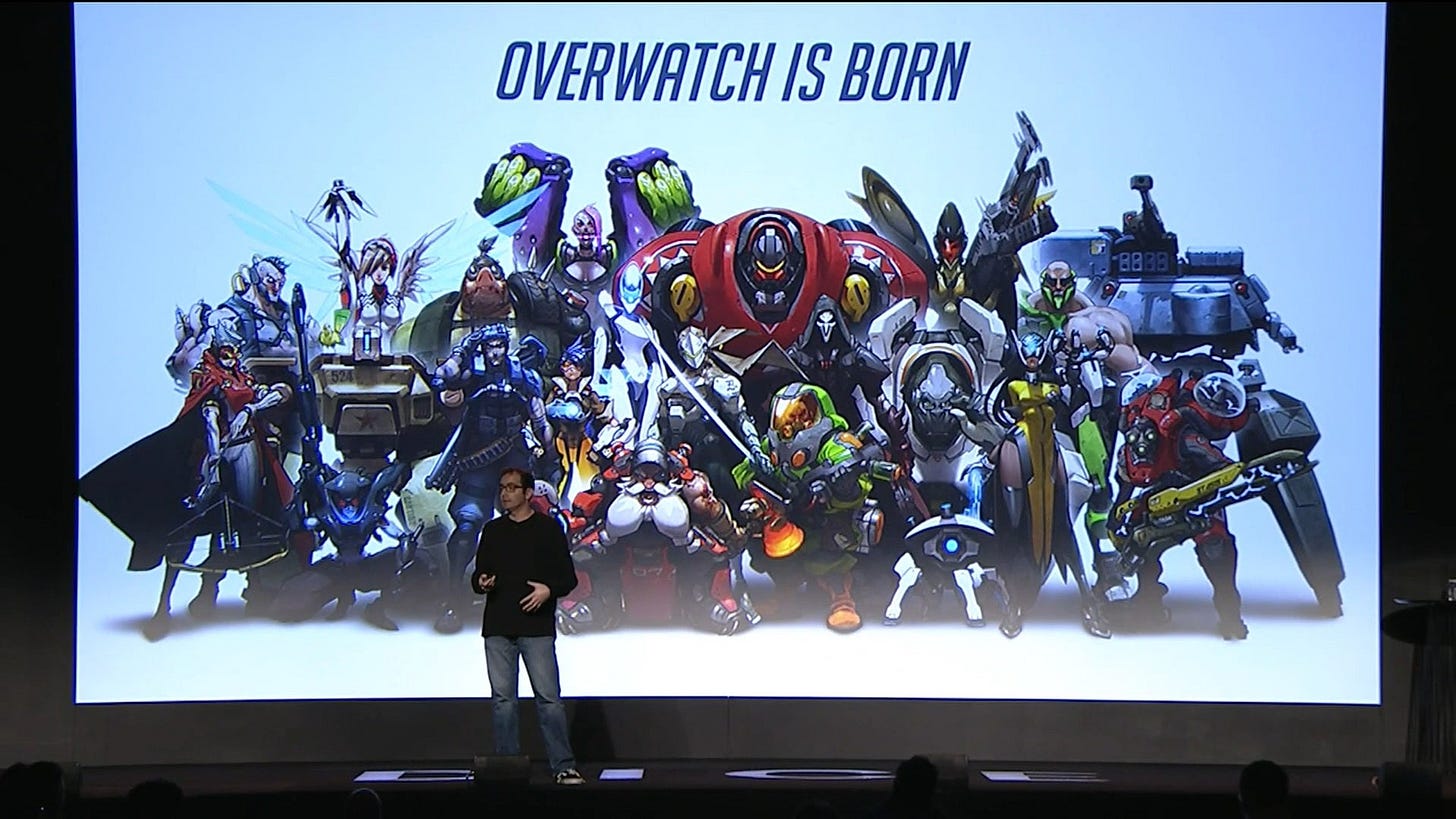Every Game Dev Should Read this Book
push to talk #40 // an interview with bestselling author and bloomberg journalist jason schreier, whose excellent new book is about the history of blizzard
Halfway through PLAY NICE, Jason Schreier’s new book about the history of Blizzard Entertainment, there’s a story that permanently altered my view of Bobby Kotick.
The story is about how Kotick, the longtime head of Activision and a perennial games industry villain, reacted to Blizzard’s pitch for Overwatch.
You can picture the scene in your head. It’s a conference room. Kotick is leaned back in his chair, stone-cold look on his face, exactly how he looked while arguing with Brad Pitt in Moneyball.1
The room is tense. It’s 2014, and the Blizzard team have just cancelled their MMO project Titan after blowing $80 million and the better part of a decade developing it.2
Jeff Kaplan and a small team have spent the last six weeks preparing a pitch to salvage pieces of Titan to turn it into a new game. They have an idea for a first-person shooter about superheroes, but they have to convince Activision leadership that they have the chops and the vision to build it.
This was the one and only shot for the fledgling Overwatch team.
The story picks up here, from chapter 21 of PLAY NICE:
Now, Kaplan and the Overwatch team had to pitch their game to a room full of executives that Blizzard staff called “sweater vests”—a pejorative reference to one of Kotick’s favorite outfits. The meeting was scheduled spontaneously, which felt ominous—was Kotick coming down to cancel the game? Did he plan to insist that Blizzard move everyone to World of Warcraft?
Things seemed dire for Kaplan and his team as the presentation began. Activision’s executives seemed disengaged and were skeptical of Blizzard’s lack of experience developing shooter games. Did Blizzard even know how to design controls for first-person shooters? Up at Activision, they had been making Call of Duty games for a decade—why would Blizzard try to do it too? And did Overwatch really fit into their portfolio when they had made a massive bet on another sci-fi shooter, called Destiny, that was due to come out in 2014?
As the tension grew, Kotick began staring at a key piece of art that Overwatch artist Arnold Tsang had drawn: a team “photograph” of more than a dozen heroes. There was the angel-like Mercy, with her staff and big gold wings; the armored ape Winston, whose furrowed brow hinted at unexpected intelligence; and many more, from hulking titans to nimble snipers. Kotick looked. And looked.
Everyone in the room was quiet, waiting for their charismatic, intimidating boss to say something. Finally he spoke up: These are the most unique characters I’ve ever seen. I love these guys.
Meeting the confused glances of his executives, Kotick explained that he believed these heroes were distinct enough to bring the shooter genre to a broader audience. “It became about the art at that point,” Kaplan said later in a Blizzard artbook. Kotick was especially charmed by Torbjörn, a diminutive engineer with a mechanized weapon suit and a bushy yellow beard that split into two braided ends. Blizzard staff would later share sneering stories about this revelation—Torbjörn? Unique? The guy who looked just like a Warcraft dwarf?—but for now, they just needed to nod and agree.
The entire tenor of the meeting changed as the other Activision executives followed their boss’s lead, and the Overwatch team went back to work with a newfound optimism.
What a twist! Bobby Kotick was the only executive in the room who understood the potential for Overwatch. And his perspective was one that merged a businessman’s instinct for market potential with artistic appreciation for the creativity of the characters?
But wait a minute: Isn’t Bobby Kotick supposed to be the bad guy?
No Heroes, No Villains
“I believe very strongly that in life there are no heroes and there are no villains,” Schreier told me in a phone conversation. “There are no cartoon characters. Everybody is a person. I think as a journalist it's really important to be aware of that.”
And yet, the story of Blizzard has traditionally been understood as a tale of pure heroes and villains, at least for a lot of Blizzard fans.
The fairy tale version of the company’s history goes something like this: Once upon a time there was a near-perfect game developer called Blizzard. Using a combination of mystic gamer knowledge and literal magic, they produced some of the greatest games of all time. And then, one day, they inexplicably merged with the evil corporation Activision (cursed be its name), which ruined the company by making everyone focus on profits.
That is not the story told in PLAY NICE.
After interviewing over 350 people—including around 300 current and former Blizzard employees—the story that Jason Schreier found is one of a company constantly dancing between unparalleled success and the edge of disaster, a pattern that held from the time of its founding in the early 90s.
The book gives an in-depth look at the development process of each of Blizzard’s games, and the overall impression is that the company had a completely different and unrepeatable—yet somehow equally chaotic—development process for every game it ever produced. The process and people that produced Diablo and Diablo II had almost nothing in common with the process and people that created StarCraft. So most of the time, they’d ship a game and come away with absolutely zero idea of how to follow it up. But then, after agonizing failures and false starts, somebody would swoop in and manage to pull a rabbit out of a hat with another hit game.
The office culture described by early Blizzard employees is one of endless toil and occasional debauchery. In between endless periods of crunch, some Blizzard dudes (and it was mostly dudes) were fighting in the offices, cheating on their wives, going to strip clubs, and getting permanently banned from hotels.
Blizzard’s Culture of Crunch
One indicative story about early Blizzard’s work environment comes from a programmer who didn’t fit into the company’s crunch-heavy culture. The programmer tells Schreier that after he complained about not getting paid for overtime, he became “the target of endless bullying around the office.” He says he began to be dismissed, derided, or simply ignored.
“So many people were shitty to me, I have to assume I brought it on myself in some way,” the programmer says. He admits to making mistakes, but says that there was also no one willing to offer mentorship or training. After less than a year on the job, the programmer was fired. “This was a dream job for me, working at Blizzard,” the programmer said. “I was absolutely crushed.”
In the end the programmer, whose name is Andy Weir, pursued other dreams. He wrote The Martian and Project Hail Mary.3
Despite Schreier’s willingness to tell these unflattering stories in PLAY NICE, the book never actually comes across as trying to tear down Blizzard or its employees. For every shocking or embarrassing story, there are stories of hard work, genuine passion, and creative brilliance.
This is, after all, the story of a company that produced many of the greatest and most influential PC games ever made.
These were people genuinely attempting to push the boundaries of the medium with every release, and often succeeding. Over time, many Blizz devs came to believe that there was no way to regulate—or, God forbid, annualize—a creative process like that. Around PLAY NICE’s second act, an unofficial slogan begins appearing in the mouths of Blizzard employees: It’ll be ready when it’s ready.
Two Years to Make It Happen
There were many moments while reading PLAY NICE that I felt recognition of things I’ve encountered in my own career.
One of the most relatable themes the book explores is the never-ending tension between the desire creatives have for freedom and the restraints imposed by outside forces, whether that be timelines, financial restraints, or strategic imperatives that require teams to limit their focus.
Creatives naturally resist such restraints, even necessary ones. And since the creatives are the ones creating value, they have well-earned leverage against the would-be managers who try to impose order and regularity upon the creative process. In some dysfunctional work environments, I’ve seen leaders give up entirely on trying to impose any kind of creative restraints. People who should know better embrace a self-destructive philosophy that says creative restraints aren’t necessary or even helpful. Devs need time and space to create great games, the weak leader reasons. And in the absence of order, chaos ensues.4
The problem with that approach is that eventually, the bill comes due.
The company will start to run out of money, or people begin to burn out after churning on a project endlessly. The game has to ship, or else the project will get cancelled. And suddenly everybody’s wondering why they’ve been working on the same game for seven or eight years.
After Blizzard’s failed Titan MMO project, Activision executives came cracking down on the studio—and for good reason. Any studio that burns eight years and $80 million shipping nothing clearly has a management problem. As PLAY NICE tells the story, Bobby Kotick kept up the pressure on Blizzard CEO Mike Morhaime even after seeming to initially approve of the Overwatch pitch. As a result, Morhaime gave Kaplan and his team an ultimatum: You have two years to make it happen.
For once, the old Blizzard slogan of “It’ll be ready when it’s ready” did not apply.
And something strange happened. Overwatch actually released two years later and it was really good. Even better, multiple Blizzard employees reported that the game’s development process was one of the smoothest they’d ever encountered.
“It was a strangely easy development cycle,” animator Michael Biancalana told Schreier. “Having been at numerous companies, seen different projects, this was the least drama filled.” Another employee, Rachel Day, echoed Biancalana’s sentiment: “The Overwatch team is the kind of development experience that you only get once. That alignment, that cooperation, that true magic.”
Is it possible that the creative restraints and tight timeline—combined with Kaplan’s clear vision—actually enabled the Overwatch team to achieve their artistic ambitions?
The Schrei Guy Speaks

“I've never thought oh, I want to be a video game writer for my entire career,” says Jason Schreier. “I'm still a little surprised that I landed here.”
His intense focus on the games industry came about almost by happenstance, after he found himself unmoored and lacking direction shortly after graduating from NYU in 2009. “I was doing some freelance journalism and I was in this local zoning board meeting for a town near where I grew up,” he says. “And they were arguing over whether a fence is allowed to be 15 feet or 20 feet. And I was just like, oh my god, I can't keep doing this. So I asked: what's something more interesting I can write about?”
He decided to try out games journalism, and it stuck. He did a bit of freelancing before landing a contract gig with WIRED in 2010. After two years, he was recruited by Kotaku’s Stephen Totilo.5 He spent eight years with Kotaku, earning a reputation as a sort of omnipresent holder of secret games industry knowledge thanks to his reporting on a wide range of leaks and games industry secrets.
“I made some enemies along the way,” Schreier says. “Though my hope is always that I’m making the right enemies.”
Since 2020, Schreier has been a reporter with Bloomberg, though his reputation has grown to levels not usually enjoyed by games journalists thanks to the success of his three books about the games industry: Blood, Sweat, and Pixels (2017), Press Reset (2021), and now PLAY NICE.
But, Schreier says, there’s a good chance that his next book will be something unrelated to games. “A large part of me wants to do fiction writing after this book,” he says. “Though if I did that, it’d be in addition to my day job.”
I told Schreier that I came away from PLAY NICE wishing there was a similar tell-all, definitive history book about legendary games companies like Riot, Epic, or (the one I really want) Valve.
“It's hard to imagine a story about a company in the video game industry being as good as the Blizzard’s,” Schreier says. “Those are fascinating companies, but I don't know if their stories have as many twists and turns or are quite as epic and sprawling as Blizzard’s.”
But, he admits, there are some conditions that would make him consider doing another book like PLAY NICE.
“If Gabe Newell called me up and said, ‘Hey Jason, I want to participate, I want to give you a tell-all, I want to give you my life story and you can talk to anyone you want, and you can write the story in any way you want…’ then I would certainly consider it.”
Somebody hit up Gabe. I heard his email address is public?
That’s it for this week. I’m gonna go boot up Diablo II and spend a few hours rearranging my inventory to be aesthetically pleasing.
I’ll see you next Friday.
This really happened. They put Bobby Kotick in Moneyball to play a business executive refusing to give somebody more money.
The film adaptation of The Martian grossed over $630 million at the worldwide box office. That is, incidentally, about $200 million more than the Warcraft movie made.
PLAY NICE tells plenty of stories of great leadership at Blizzard. In the early sections of the book, you learn how Blizzard co-founder Allen Adham earned the nickname “The Velvet Hammer” by acting as a calm but persuasive voice to reign in and guide creative teams working on the studio’s early games. You can still see this energy in Adham in recent interviews, particularly his fascinating conversation with Lester Chen from A16Z GAMES.
I have a personal connection with Schreier—I once backfilled his old job. When Schreier left WIRED to join Kotaku in 2012, he left big shoes to fill. I was a young, ambitious freelancer who somehow managed to land the role, which reported to editor Chris Kohler.
“Chris Kohler and Stephen Totilo are the two people who have taught me the most over the years,” Schreier told me when I phoned him up this week. “Without them, I wouldn’t be where I am today.”







I think it's so easy these days to apply simple narratives to complex situations, especially by game news bloggers who push tabloid controversy so they stay part of the conversation. So it's easy to cast Kotick as a villain, because that makes for fun headlines and simplistic binary narratives. Kinda reminds me of how Jimmy Iodine's bullying of Smashmouth led to All-Star.
This book is definitely on my to-do list. Also, quite interesting how one sentence from Kotick could turn the whole meeting around...